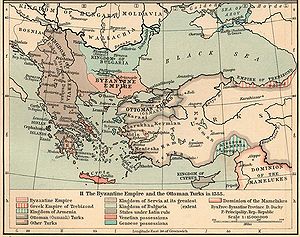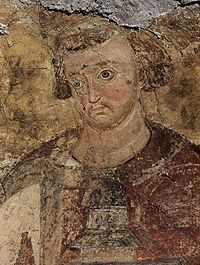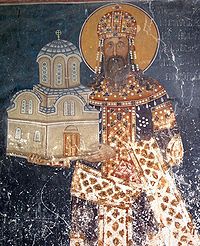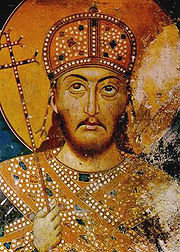
Nemanyid Serbia
Encyclopedia
The Kingdom of Serbia or Serbian Kingdom was a medieval Serb kingdom ruled by the Nemanjić dynasty, from 1217 to 1346. The Serbian Grand Principality
was elevated with the coronation of Stefan Prvovenčani (The First-crowned) as "King of Serbia
" by his brother, bishop Sava
, after inheriting all territories unified by their father, Stefan Nemanja
, who is regarded the most remarkable Serb
according to the SANU (Academy)
. It was proclaimed an Empire on 16 April, 1346.
, the son of Vukan, ruled Serbia when the Byzantines invaded Duklja, and Rascia would be next in line, but with diplomatic ties with the Kingdom of Hungary
, Serbia retained its indepence. Uroš II
initially fought the Byzantines, but after a defeat soon gives oaths of servitude to the Emperor. Desa, the brother of Uroš II and an initial Byzantine ally, turned to Hungarian support, but was deposed in 1163, when Stefan Tihomir of a cadet line (which would become Nemanjić dynasty), was put on the throne by the Emperor.
already had ambitions to spread its influence to the Balkans as well, Stefan used these propitious circumstances to obtain his crown from the Pope, thereby becoming the first Serbian king, in 1217. In Byzantium, his brother Sava managed to secure autocephaly
(independence) for the Serbian Church and became the first Serbian archiepiscope
in 1219. In the same year Sava
published the first constitution
in Serbia
— St. Sava's Nomocanon . This legal act was well developed. St. Sava's Nomocanon was the compilation of Civil law
, based on Roman Law
and Canon law
, based on Ecumenical Councils and its basic purpose was to organize functioning of the young Serbian kingdom and the Serbian church. Thus the Serbs acquired both forms of independence: political and religious.
The next generation of Serbian rulers — the sons of Stefan Prvovenčani — Radoslav, Vladislav and Uroš I, marked a period of stagnation of the state structure. All three kings were more or less dependent on some of the neighbouring states — Byzantium
, Bulgaria
or Hungary. The ties with the Hungarians played a decisive role in the fact that Uroš I was succeeded by his son Dragutin whose wife was a Hungarian princess. Later on, when Dragutin abdicated in favour of his younger brother Milutin (in 1282), the Hungarian king Ladislaus IV gave him lands in northeastern Bosnia
, the region of Mačva
, and the city of Belgrade
, whilst he managed to conquer and annex lands in northeastern Serbia
. Thus, some of these territories became part of the Serbian state for the first time. His new state was named Kingdom of Srem. In that time the name Srem was a designation for two territories: Upper Srem (present day Srem) and Lower Srem (present day Mačva). Kingdom of Srem under the rule of Stefan Dragutin was actually Lower Srem, but some historical sources mention that Stefan Dragutin also ruled over Upper Srem and Slavonia
. After Dragutin died (in 1316), the new ruler of the Kingdom of Srem became his son, king Vladislav II, who ruled this state until 1325.
Under the rule of Dragutin's younger brother — King Milutin, Serbia grew stronger despite having to occasionally fight wars on three different fronts. King Milutin was an apt diplomat much inclined to the use of a customary medieval diplomatic and dynastic marriages. He was married five times, with Hungarian, Bulgarian and Byzantine princesses. He is also famous for building churches, some of which are the finest examples of Medieval Serbian architecture: the Gračanica monastery
in Kosovo, the Cathedral in Hilandar monastery on Mount Athos
, the St. Archangel Church in Jerusalem etc.
Because of his endowments, King Milutin has been proclaimed a saint, in spite of his tumultuous life. He was succeeded on the throne by his son Stefan, later dubbed Stefan Dečanski. Spreading the kingdom to the east by winning the town of Nis and the surrounding counties, and to the south by acquiring territories on Macedonia, Stefan Dečanski was worthy of his father and built the Visoki Dečani monastery
in Metohija — the most monumental example of Serbian Medieval architecture — that earned him his nickname. Stefan Dečanski defeated the Bulgarians
in Battle of Velbužd
in 1330.
 Taking advantage of the Byzantine civil war of 1341–1347
Taking advantage of the Byzantine civil war of 1341–1347
, Dušan doubled the size of his kingdom seizing territories to the south, southeast and east at the expense of Byzantium and conquered almost the entire territory of today's Greece, except the Peloponnese
and the islands. After he conquered the city of Serres
, he was crowned the Emperor of Serbs and Greeks in Skoplje by the Serbian Patriarch on April 16, 1346. His goal was to become the successor of the Byzantine Emperors. Before his sudden death, Dušan the Mighty tried to organize a Crusade with the Pope against the threatening Turks. He died in December 1355 at the age 47. The Imperial constitution, the Dušan's Code
was enacted in 1349 and added in 1354. The Code was based on Roman
-Byzantine law
. The legal transplanting is notable with the articles 171 and 172 of Dušan's Code, which regulated the juridical independence. They were taken from the Byzantine code Basilika
(book VII, 1, 16-17). Dušan opened new trade routes and strengthened the state's economy. Serbia flourished, becoming one of the most developed countries and cultures in Europe
. Medieval Serbia had a high political, economic, and cultural reputation in Europe.
Serbian Grand Principality
The Serbian Grand Principality or Rascia was a medieval state that was founded in 1090, and ended with the elevation to Kingdom in 1217. During the reign of Constantine Bodin, the King of Duklja, Vukan was appointed to rule Rascia as a vassal, and when Bodin was captured by the Byzantines, Vukan...
was elevated with the coronation of Stefan Prvovenčani (The First-crowned) as "King of Serbia
Serbian titles
-Archont of Serbia:*Archont of Serbia -Grand Prince of Serbia:*Great/Grand Župan of Serbia-Emperor of Serbia:*Emperor of the Serbs and the Greeks -Stefan:...
" by his brother, bishop Sava
Saint Sava
Saint Sava was a Serbian Prince and Orthodox monk, the first Archbishop of the autocephalous Serbian Church, the founder of Serbian law and literature, and a diplomat. Sava was born Rastko Nemanjić , the youngest son of Serbian Grand Župan Stefan Nemanja , and ruled the appanage of Hum briefly in...
, after inheriting all territories unified by their father, Stefan Nemanja
Stefan Nemanja
Stefan Nemanja was the Grand Prince of the Grand Principality of Serbia from 1166 to 1196, a heir of the Vukanović dynasty that marked the beginning of a greater Serbian realm .He is remembered for his contributions to Serbian culture and...
, who is regarded the most remarkable Serb
Serbs
The Serbs are a South Slavic ethnic group of the Balkans and southern Central Europe. Serbs are located mainly in Serbia, Montenegro and Bosnia and Herzegovina, and form a sizable minority in Croatia, the Republic of Macedonia and Slovenia. Likewise, Serbs are an officially recognized minority in...
according to the SANU (Academy)
Serbian Academy of Sciences and Arts
The Serbian Academy of Sciences and Arts is the most prominent academic institution in Serbia today...
. It was proclaimed an Empire on 16 April, 1346.
Serbian Grand Principality
The Serbian Grand Principality, also known in western sources as Rascia, was founded in 1091, when Vukan took the title of Grand Prince of Serbia. During the reign of Constantine Bodin, the King of Duklja, Vukan was appointed to rule Rascia as a vassal, and when Bodin was captured by the Byzantines, Vukan became independent. When Bodin had died, "Rascia" (in the hinterland) became the strongest entity, in which the Serbian realm would be seated, in hands of the Vukanović dynasty. Uroš IUroš I of Rascia
Uroš I Vukanović was the Grand Prince of the Grand Principality of Serbia from ca 1112 to 1145.-Origin:Uroš I was the son of Marko, the brother of Grand Prince Vukan, who had swore an oath of loyalty to Constantine Bodin, the Grand Prince of Duklja, becoming his vassals...
, the son of Vukan, ruled Serbia when the Byzantines invaded Duklja, and Rascia would be next in line, but with diplomatic ties with the Kingdom of Hungary
Kingdom of Hungary
The Kingdom of Hungary comprised present-day Hungary, Slovakia and Croatia , Transylvania , Carpatho Ruthenia , Vojvodina , Burgenland , and other smaller territories surrounding present-day Hungary's borders...
, Serbia retained its indepence. Uroš II
Uroš II Prvoslav
Uroš II, also known as Primislav was Serbian Grand Prince from ca. 1145 to 1162, with brief interruptions as ruler by Desa, his brother. His rule was characterized by a period of power struggle, not only of the Serbian throne between the brothers, but between the Byzantine Empire and Hungarian...
initially fought the Byzantines, but after a defeat soon gives oaths of servitude to the Emperor. Desa, the brother of Uroš II and an initial Byzantine ally, turned to Hungarian support, but was deposed in 1163, when Stefan Tihomir of a cadet line (which would become Nemanjić dynasty), was put on the throne by the Emperor.
History
Stefan Nemanja was succeeded by his middle son Stefan, whilst his first-born son Vukan was given the rule of the Zeta region (present-day Montenegro). Stefan Nemanja's youngest son Rastko became a monk and took the name Sava, turning all his efforts to spread religion among his people. Since the Roman Catholic ChurchRoman Catholic Church
The Catholic Church, also known as the Roman Catholic Church, is the world's largest Christian church, with over a billion members. Led by the Pope, it defines its mission as spreading the gospel of Jesus Christ, administering the sacraments and exercising charity...
already had ambitions to spread its influence to the Balkans as well, Stefan used these propitious circumstances to obtain his crown from the Pope, thereby becoming the first Serbian king, in 1217. In Byzantium, his brother Sava managed to secure autocephaly
Autocephaly
Autocephaly , in hierarchical Christian churches and especially Eastern Orthodox and Oriental Orthodox churches, is the status of a hierarchical church whose head bishop does not report to any higher-ranking bishop...
(independence) for the Serbian Church and became the first Serbian archiepiscope
Archbishop
An archbishop is a bishop of higher rank, but not of higher sacramental order above that of the three orders of deacon, priest , and bishop...
in 1219. In the same year Sava
Saint Sava
Saint Sava was a Serbian Prince and Orthodox monk, the first Archbishop of the autocephalous Serbian Church, the founder of Serbian law and literature, and a diplomat. Sava was born Rastko Nemanjić , the youngest son of Serbian Grand Župan Stefan Nemanja , and ruled the appanage of Hum briefly in...
published the first constitution
Constitution
A constitution is a set of fundamental principles or established precedents according to which a state or other organization is governed. These rules together make up, i.e. constitute, what the entity is...
in Serbia
Serbia
Serbia , officially the Republic of Serbia , is a landlocked country located at the crossroads of Central and Southeast Europe, covering the southern part of the Carpathian basin and the central part of the Balkans...
— St. Sava's Nomocanon . This legal act was well developed. St. Sava's Nomocanon was the compilation of Civil law
Civil law (legal system)
Civil law is a legal system inspired by Roman law and whose primary feature is that laws are codified into collections, as compared to common law systems that gives great precedential weight to common law on the principle that it is unfair to treat similar facts differently on different...
, based on Roman Law
Roman law
Roman law is the legal system of ancient Rome, and the legal developments which occurred before the 7th century AD — when the Roman–Byzantine state adopted Greek as the language of government. The development of Roman law comprises more than a thousand years of jurisprudence — from the Twelve...
and Canon law
Canon law
Canon law is the body of laws & regulations made or adopted by ecclesiastical authority, for the government of the Christian organization and its members. It is the internal ecclesiastical law governing the Catholic Church , the Eastern and Oriental Orthodox churches, and the Anglican Communion of...
, based on Ecumenical Councils and its basic purpose was to organize functioning of the young Serbian kingdom and the Serbian church. Thus the Serbs acquired both forms of independence: political and religious.
The next generation of Serbian rulers — the sons of Stefan Prvovenčani — Radoslav, Vladislav and Uroš I, marked a period of stagnation of the state structure. All three kings were more or less dependent on some of the neighbouring states — Byzantium
Byzantium
Byzantium was an ancient Greek city, founded by Greek colonists from Megara in 667 BC and named after their king Byzas . The name Byzantium is a Latinization of the original name Byzantion...
, Bulgaria
Bulgaria
Bulgaria , officially the Republic of Bulgaria , is a parliamentary democracy within a unitary constitutional republic in Southeast Europe. The country borders Romania to the north, Serbia and Macedonia to the west, Greece and Turkey to the south, as well as the Black Sea to the east...
or Hungary. The ties with the Hungarians played a decisive role in the fact that Uroš I was succeeded by his son Dragutin whose wife was a Hungarian princess. Later on, when Dragutin abdicated in favour of his younger brother Milutin (in 1282), the Hungarian king Ladislaus IV gave him lands in northeastern Bosnia
Bosnia (region)
Bosnia is a eponomous region of Bosnia and Herzegovina. It lies mainly in the Dinaric Alps, ranging to the southern borders of the Pannonian plain, with the rivers Sava and Drina marking its northern and eastern borders. The other eponomous region, the southern, other half of the country is...
, the region of Mačva
Macva
Mačva is a geographical region in Serbia, mostly situated in the northwest of Central Serbia. It is located in a fertile plain between the Sava and Drina rivers. The chief town of this region is Šabac. The modern Mačva District of Serbia is named after the region, although the region of Mačva...
, and the city of Belgrade
Belgrade
Belgrade is the capital and largest city of Serbia. It is located at the confluence of the Sava and Danube rivers, where the Pannonian Plain meets the Balkans. According to official results of Census 2011, the city has a population of 1,639,121. It is one of the 15 largest cities in Europe...
, whilst he managed to conquer and annex lands in northeastern Serbia
Serbia
Serbia , officially the Republic of Serbia , is a landlocked country located at the crossroads of Central and Southeast Europe, covering the southern part of the Carpathian basin and the central part of the Balkans...
. Thus, some of these territories became part of the Serbian state for the first time. His new state was named Kingdom of Srem. In that time the name Srem was a designation for two territories: Upper Srem (present day Srem) and Lower Srem (present day Mačva). Kingdom of Srem under the rule of Stefan Dragutin was actually Lower Srem, but some historical sources mention that Stefan Dragutin also ruled over Upper Srem and Slavonia
Slavonia
Slavonia is a geographical and historical region in eastern Croatia...
. After Dragutin died (in 1316), the new ruler of the Kingdom of Srem became his son, king Vladislav II, who ruled this state until 1325.
Under the rule of Dragutin's younger brother — King Milutin, Serbia grew stronger despite having to occasionally fight wars on three different fronts. King Milutin was an apt diplomat much inclined to the use of a customary medieval diplomatic and dynastic marriages. He was married five times, with Hungarian, Bulgarian and Byzantine princesses. He is also famous for building churches, some of which are the finest examples of Medieval Serbian architecture: the Gračanica monastery
Gracanica monastery
Gračanica is a Serbian Orthodox monastery located in Kosovo. It was founded by the Serbian king Stefan Milutin in 1321. Gračanica Monastery was declared Monument of Culture of Exceptional Importance in 1990, and it is protected by Republic of Serbia, and on 13 July 2006 it was placed on UNESCO's...
in Kosovo, the Cathedral in Hilandar monastery on Mount Athos
Mount Athos
Mount Athos is a mountain and peninsula in Macedonia, Greece. A World Heritage Site, it is home to 20 Eastern Orthodox monasteries and forms a self-governed monastic state within the sovereignty of the Hellenic Republic. Spiritually, Mount Athos comes under the direct jurisdiction of the...
, the St. Archangel Church in Jerusalem etc.
Because of his endowments, King Milutin has been proclaimed a saint, in spite of his tumultuous life. He was succeeded on the throne by his son Stefan, later dubbed Stefan Dečanski. Spreading the kingdom to the east by winning the town of Nis and the surrounding counties, and to the south by acquiring territories on Macedonia, Stefan Dečanski was worthy of his father and built the Visoki Dečani monastery
Visoki Decani monastery
Visoki Dečani is a major Serbian Orthodox Christian monastery located in Kosovo, south of the town of Peć. The monastic katholikon is the largest medieval church in the Balkans containing the most extensive preserved fresco decoration.- History :The monastery was established in a chestnut grove...
in Metohija — the most monumental example of Serbian Medieval architecture — that earned him his nickname. Stefan Dečanski defeated the Bulgarians
Bulgarians
The Bulgarians are a South Slavic nation and ethnic group native to Bulgaria and neighbouring regions. Emigration has resulted in immigrant communities in a number of other countries.-History and ethnogenesis:...
in Battle of Velbužd
Battle of Velbužd
The Battle of Velbazhd is a battle which took place between Bulgarian and Serbian armies on 28 July 1330, near the town of Velbazhd ....
in 1330.
Serbian Empire

Byzantine civil war of 1341–1347
The Byzantine civil war of 1341–1347 was a conflict between supporters of designated regent John VI Kantakouzenos and guardians acting for John V Palaiologos, Emperor Andronikos III's nine-year-old son, in the persons of the Empress-dowager Anna of Savoy, the Patriarch of Constantinople John XIV...
, Dušan doubled the size of his kingdom seizing territories to the south, southeast and east at the expense of Byzantium and conquered almost the entire territory of today's Greece, except the Peloponnese
Peloponnese
The Peloponnese, Peloponnesos or Peloponnesus , is a large peninsula , located in a region of southern Greece, forming the part of the country south of the Gulf of Corinth...
and the islands. After he conquered the city of Serres
Serres
Serres is a city in Greece, seat of the Serres prefecture.Serres may also refer to:Places:* Serres, Germany, a part of Wiernsheim in Baden-WürttembergIn France:* Serres, Aude in the Aude département...
, he was crowned the Emperor of Serbs and Greeks in Skoplje by the Serbian Patriarch on April 16, 1346. His goal was to become the successor of the Byzantine Emperors. Before his sudden death, Dušan the Mighty tried to organize a Crusade with the Pope against the threatening Turks. He died in December 1355 at the age 47. The Imperial constitution, the Dušan's Code
Dušan's Code
Dušan's Code was enacted by Tsar Dušan in two state congresses: in May 21, 1349 in Skopje and amended in 1354 in Serres. It regulated all social spheres, so it can be considered a medieval Serbian constitution. The Code included 201 articles. The original manuscript is not preserved, but around...
was enacted in 1349 and added in 1354. The Code was based on Roman
Roman law
Roman law is the legal system of ancient Rome, and the legal developments which occurred before the 7th century AD — when the Roman–Byzantine state adopted Greek as the language of government. The development of Roman law comprises more than a thousand years of jurisprudence — from the Twelve...
-Byzantine law
Byzantine law
Byzantine Law was essentially a continuation of Roman Law with Christian influence, however, this is not to doubt its later influence on the western practice of jurisprudence...
. The legal transplanting is notable with the articles 171 and 172 of Dušan's Code, which regulated the juridical independence. They were taken from the Byzantine code Basilika
Basilika
The term Basilika or 'Basilica' refers to a code of laws issued by the Eastern Roman emperor Leo VI the Wise . Written entirely in Greek, the 'Basilica', in 60 books, adapt the 6th-century Justinian code to the conditions of the 9th- and 10th-century Empire, and include laws issued by Leo VI and...
(book VII, 1, 16-17). Dušan opened new trade routes and strengthened the state's economy. Serbia flourished, becoming one of the most developed countries and cultures in Europe
Europe
Europe is, by convention, one of the world's seven continents. Comprising the westernmost peninsula of Eurasia, Europe is generally 'divided' from Asia to its east by the watershed divides of the Ural and Caucasus Mountains, the Ural River, the Caspian and Black Seas, and the waterways connecting...
. Medieval Serbia had a high political, economic, and cultural reputation in Europe.
Monarchs
| King | Reign | Notes |
|---|---|---|
the First-crowned |
1217-1228 |
|
 Stephen Radoslav Stephen Radoslav |
1228–1233 |
|
 Stephen Vladislav Stephen Vladislav |
1233–1243 |
|
 Stephen Uroš I Stephen Uroš I |
1243–1276 |
|
| 1276-1282 |
|
|
 Stephen Uroš II Milutin Stephen Uroš II Milutin |
1282–1321 |
|
of Dečani Decani Decani is the side of a church choir occupied by the Dean. In English churches this is typically the choir stalls on the south side of the chancel, although there are some notable exceptions, such as Durham Cathedral and Southwell Minster... |
1321–1331 |
|
 Stephen Uroš IV Dušan Stephen Uroš IV Dušanthe Mighty |
1331-1355 |
|
Sources
- John V.A. Fine. (1994). The Late Medieval Balkans: A Critical Survey from the Late Twelfth Century to the Ottoman Conquest. The University of Michigan Press. ISBN 0-472-08260-4
- John V.A. Fine. (1991). The early Medieval Balkans: A Critical Survey from the 6th to the Late 12th Century. The University of Michigan Press. ISBN 0-472-08149-7
- Alexander Soloviev, "Greek charters of Serbian rulers" (1936), Soloviev and Makin

